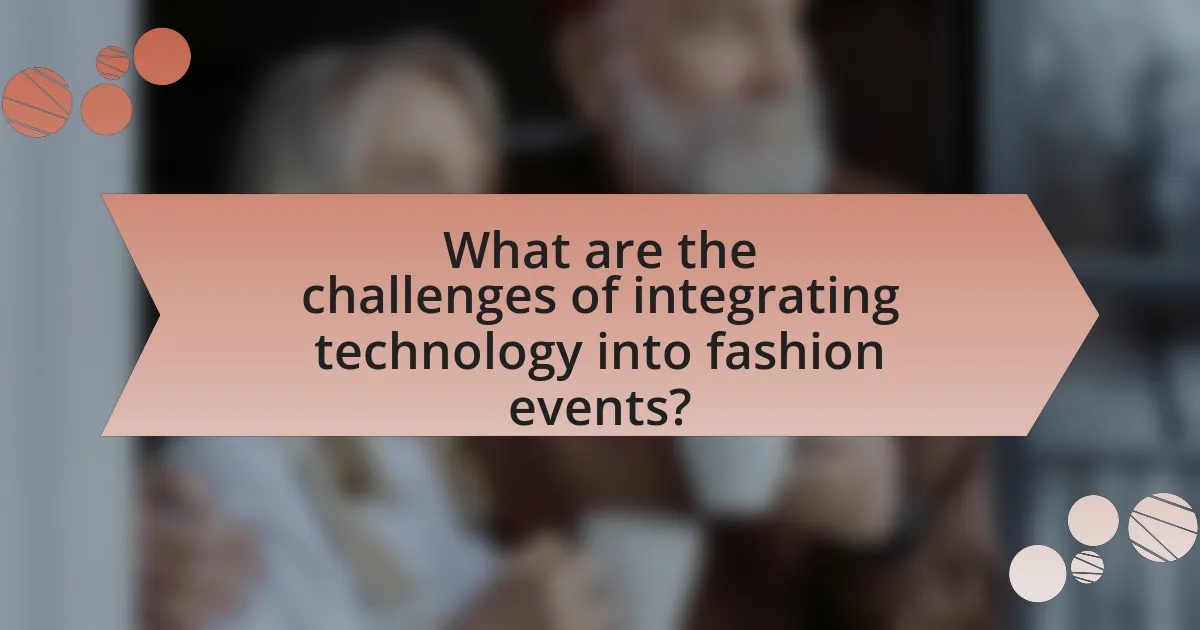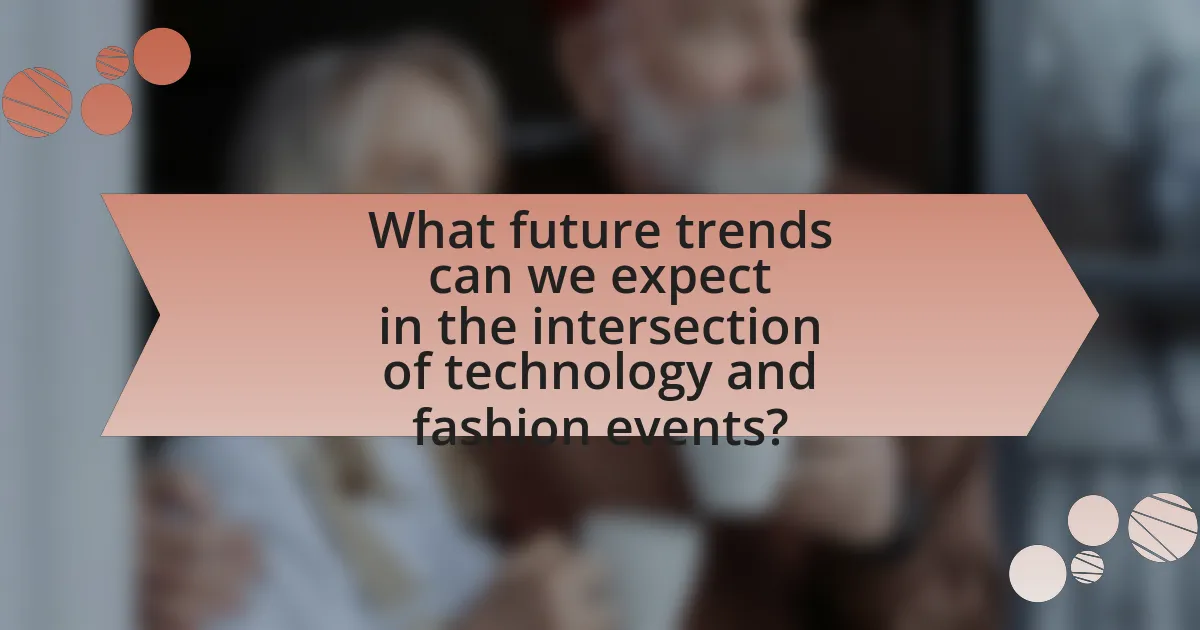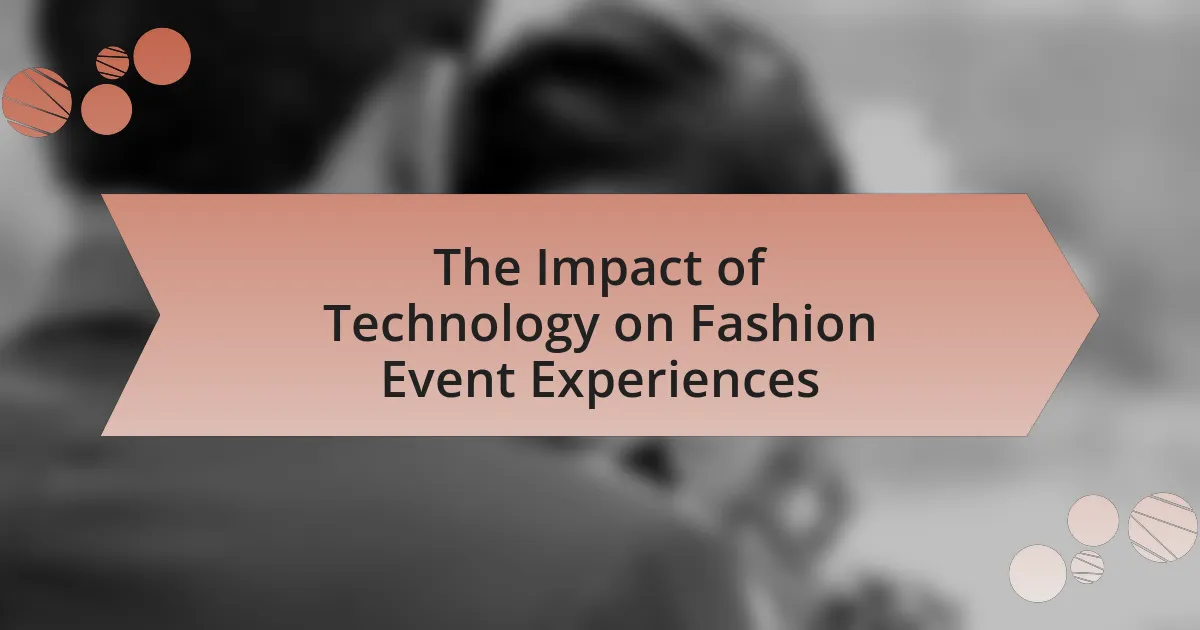The article examines the significant impact of technology on fashion event experiences, highlighting how advancements such as live streaming, augmented reality (AR), and virtual reality (VR) enhance engagement and accessibility for audiences. It discusses the transformation of event organization through digital tools that streamline logistics and broaden audience reach, particularly during the COVID-19 pandemic. Additionally, the article explores the role of social media and influencers in promoting events, the challenges of integrating technology, and future trends that may shape the fashion industry. Key technological tools and their benefits for event management and attendee experiences are also analyzed, providing a comprehensive overview of the intersection between technology and fashion events.

What is the Impact of Technology on Fashion Event Experiences?
The impact of technology on fashion event experiences is significant, enhancing engagement and accessibility. Technologies such as live streaming, augmented reality (AR), and virtual reality (VR) allow audiences to participate in events remotely, broadening reach beyond physical attendees. For instance, during the 2021 New York Fashion Week, designers utilized live streaming to showcase collections to millions globally, demonstrating a shift towards digital inclusivity. Additionally, AR applications enable users to visualize clothing on themselves through their devices, improving customer interaction and decision-making. These advancements not only elevate the overall experience but also drive sales and brand loyalty by creating immersive environments that resonate with consumers.
How has technology transformed the way fashion events are organized?
Technology has significantly transformed the organization of fashion events by streamlining processes and enhancing audience engagement. Digital tools such as event management software facilitate efficient planning, scheduling, and coordination among teams, reducing the time and effort required for logistics. Additionally, live streaming and social media platforms allow brands to reach a global audience, increasing visibility and engagement beyond physical attendees. For instance, during the COVID-19 pandemic, many fashion shows transitioned to virtual formats, exemplifying how technology can adapt to challenges while maintaining audience connection. This shift not only broadened access but also provided valuable data analytics on viewer engagement, enabling brands to tailor future events more effectively.
What technological tools are commonly used in fashion event planning?
Technological tools commonly used in fashion event planning include event management software, virtual reality (VR) platforms, and social media marketing tools. Event management software, such as Cvent or Eventbrite, streamlines registration, ticketing, and attendee management, enhancing operational efficiency. Virtual reality platforms allow designers and brands to create immersive experiences, enabling potential customers to engage with collections in innovative ways. Social media marketing tools, like Hootsuite or Buffer, facilitate targeted promotions and real-time engagement with audiences, which is crucial for maximizing event visibility and attendance. These tools collectively enhance the planning process and improve overall event experiences in the fashion industry.
How do these tools enhance the efficiency of event management?
Event management tools enhance efficiency by automating tasks such as registration, scheduling, and communication. These tools streamline processes, reducing manual effort and minimizing errors, which allows event planners to focus on strategic aspects rather than administrative details. For instance, platforms like Eventbrite and Cvent provide real-time data analytics, enabling planners to make informed decisions quickly. According to a study by the Event Marketing Institute, 70% of event professionals reported that technology significantly improved their event planning efficiency, demonstrating the tangible benefits of these tools in managing complex logistics and enhancing attendee engagement.
What role does technology play in enhancing attendee experiences at fashion events?
Technology plays a crucial role in enhancing attendee experiences at fashion events by facilitating interactive engagement and providing real-time information. For instance, augmented reality (AR) applications allow attendees to visualize clothing on themselves without trying them on, significantly improving the shopping experience. Additionally, live streaming technology enables remote participation, allowing a broader audience to engage with the event, as evidenced by the 2021 New York Fashion Week, which attracted millions of online viewers. Furthermore, social media integration encourages attendees to share their experiences instantly, creating a sense of community and increasing brand visibility. These technological advancements not only enrich the attendee experience but also drive greater engagement and reach for fashion brands.
How do virtual and augmented reality influence attendee engagement?
Virtual and augmented reality significantly enhance attendee engagement by creating immersive experiences that captivate participants. These technologies allow attendees to interact with digital content in real-time, fostering a deeper emotional connection to the event. For instance, a study by PwC found that immersive experiences can increase engagement levels by up to 30%, as participants are more likely to remember and share their experiences. Additionally, augmented reality applications enable attendees to visualize products in their own environment, which can lead to higher satisfaction and increased likelihood of purchase.
What are the benefits of live streaming fashion events for global audiences?
Live streaming fashion events offers global audiences immediate access to exclusive content, enhancing engagement and reach. This technology allows viewers from diverse geographical locations to experience runway shows and presentations in real-time, breaking down barriers of location and cost. According to a report by McKinsey & Company, the global fashion industry saw a 20% increase in online engagement during live-streamed events, demonstrating the effectiveness of this approach in attracting a wider audience. Additionally, live streaming enables brands to gather valuable data on viewer preferences and behaviors, which can inform future marketing strategies.
How does social media impact the promotion of fashion events?
Social media significantly enhances the promotion of fashion events by providing a platform for real-time engagement and broad audience reach. It allows brands and organizers to share event details, behind-the-scenes content, and live updates, which can generate excitement and anticipation among potential attendees. For instance, a study by the Fashion Institute of Technology found that 70% of fashion event attendees reported discovering events through social media platforms. Additionally, social media enables targeted advertising, allowing fashion brands to reach specific demographics effectively, which can lead to increased attendance and brand visibility.
What platforms are most effective for fashion event marketing?
Social media platforms, particularly Instagram, Facebook, and TikTok, are the most effective for fashion event marketing. These platforms enable brands to showcase their events visually, engage with audiences through interactive content, and leverage influencer partnerships to reach wider demographics. For instance, Instagram’s visual-centric approach allows for high-quality imagery and videos that capture the essence of fashion events, while TikTok’s short-form video format encourages creative storytelling and viral trends. According to a 2022 report by Statista, 54% of fashion brands reported that social media significantly increased their event attendance, highlighting the effectiveness of these platforms in driving engagement and participation.
How do influencers shape the perception of fashion events through technology?
Influencers shape the perception of fashion events through technology by leveraging social media platforms to amplify their reach and engagement. They create real-time content, such as live streams and posts, that showcase the event’s highlights, thereby influencing audience perceptions and increasing visibility. For instance, a study by the Fashion Institute of Technology found that 70% of consumers are more likely to attend an event if they see it promoted by an influencer they follow. This demonstrates how influencers utilize technology to enhance the appeal of fashion events, making them more accessible and desirable to a broader audience.

What are the challenges of integrating technology into fashion events?
Integrating technology into fashion events presents several challenges, including high costs, technical difficulties, and the need for skilled personnel. High costs arise from the investment required for advanced technology, such as augmented reality or live streaming equipment, which can strain budgets. Technical difficulties often occur due to the complexity of integrating various technologies, leading to potential malfunctions during events. Additionally, the need for skilled personnel to operate and manage these technologies can create staffing challenges, as not all fashion event teams possess the necessary technical expertise. These factors collectively hinder the seamless incorporation of technology into fashion events.
What technical issues can arise during fashion events?
Technical issues that can arise during fashion events include equipment failures, connectivity problems, and software malfunctions. Equipment failures may involve lighting, sound systems, or projection devices, which can disrupt presentations and affect audience engagement. Connectivity problems often occur with Wi-Fi or network access, hindering live streaming or real-time social media interactions. Software malfunctions can impact registration systems or digital displays, leading to delays and confusion among attendees. These issues have been documented in various fashion events, highlighting the critical need for reliable technology to ensure smooth operations.
How can event organizers prepare for potential technology failures?
Event organizers can prepare for potential technology failures by implementing a comprehensive contingency plan that includes backup systems and regular testing of all technology. This proactive approach ensures that in the event of a failure, organizers can quickly switch to alternative solutions, minimizing disruption. For instance, having backup power sources, such as generators, and redundant internet connections can maintain operations during outages. Additionally, conducting rehearsals that simulate technology failures allows organizers to identify weaknesses in their setup and refine their response strategies. According to a study by the Event Safety Alliance, 70% of event professionals reported that having a contingency plan significantly reduced the impact of technology failures on their events.
What are the privacy concerns associated with technology use at events?
The privacy concerns associated with technology use at events include data collection, surveillance, and unauthorized sharing of personal information. Attendees often provide personal data through event registration, mobile apps, and social media interactions, which can be misused if not properly secured. For instance, a study by the International Association of Privacy Professionals found that 70% of consumers are concerned about how their data is used at events. Additionally, technologies like facial recognition and location tracking can lead to invasive monitoring, raising ethical questions about consent and privacy rights. These concerns highlight the need for robust data protection measures and transparent privacy policies at events.
How do budget constraints affect the adoption of technology in fashion events?
Budget constraints significantly limit the adoption of technology in fashion events by restricting financial resources available for innovative tools and solutions. When event organizers face tight budgets, they often prioritize essential expenses, such as venue costs and staffing, over advanced technological investments like augmented reality displays or live streaming services. A study by the Fashion Institute of Technology found that 65% of event planners cited budget limitations as a primary barrier to implementing new technologies, indicating a direct correlation between financial resources and technological adoption. Consequently, this financial pressure can lead to less engaging experiences for attendees, as organizers may resort to traditional methods rather than leveraging cutting-edge technology that enhances interaction and visibility.
What cost-effective solutions exist for small fashion events?
Cost-effective solutions for small fashion events include utilizing digital platforms for virtual showcases, leveraging social media for marketing, and collaborating with local vendors for resources. Digital platforms like Zoom or Instagram Live allow designers to reach a wider audience without the costs associated with physical venues. Social media marketing is a low-cost method to promote events, with statistics showing that 73% of marketers believe that their efforts through social media marketing have been “somewhat effective” or “very effective” for their business. Collaborating with local vendors can reduce expenses related to catering, decor, and venue rental, as many local businesses are willing to partner for mutual promotion. These strategies collectively enhance the event experience while minimizing costs.
How can larger events justify their technology investments?
Larger events can justify their technology investments by demonstrating enhanced attendee engagement and operational efficiency. For instance, the integration of advanced technologies such as augmented reality (AR) and virtual reality (VR) has been shown to increase participant interaction, with studies indicating that events utilizing AR can boost engagement rates by up to 70%. Additionally, technology investments streamline event management processes, reducing costs and time; for example, event management software can cut planning time by 30%, allowing organizers to allocate resources more effectively. These metrics provide concrete evidence that technology investments yield significant returns in both participant satisfaction and operational effectiveness.

What future trends can we expect in the intersection of technology and fashion events?
Future trends in the intersection of technology and fashion events include the increased use of augmented reality (AR) and virtual reality (VR) to enhance attendee experiences. These technologies allow for immersive fashion shows where viewers can interact with digital garments and environments, as evidenced by brands like Balenciaga and Gucci utilizing VR platforms for their runway presentations. Additionally, artificial intelligence (AI) is expected to play a significant role in personalizing event experiences, with algorithms analyzing attendee preferences to tailor recommendations and interactions. The integration of blockchain technology for supply chain transparency and authenticity verification is also anticipated, as it addresses consumer demand for ethical fashion practices. These trends reflect a shift towards more engaging, personalized, and transparent fashion events, driven by technological advancements.
How will advancements in technology shape the future of fashion events?
Advancements in technology will significantly shape the future of fashion events by enhancing interactivity, accessibility, and sustainability. Virtual reality (VR) and augmented reality (AR) will allow attendees to experience fashion shows from anywhere in the world, breaking geographical barriers and increasing audience reach. For instance, brands like Balenciaga have already utilized VR to create immersive experiences for their collections, demonstrating the potential for wider engagement.
Moreover, live streaming and social media integration will enable real-time interaction between designers and audiences, fostering a more inclusive environment. According to a report by McKinsey & Company, the digital transformation in fashion events can lead to a 30% increase in audience engagement, showcasing the effectiveness of these technologies.
Sustainability will also be enhanced through technology, as digital platforms can reduce the need for physical materials and travel, aligning with the industry’s growing focus on eco-friendliness. The use of 3D printing and digital fashion design can minimize waste, further supporting sustainable practices in fashion events. Thus, technology is poised to revolutionize the fashion event landscape by making it more engaging, accessible, and environmentally responsible.
What emerging technologies are likely to be adopted in upcoming fashion events?
Emerging technologies likely to be adopted in upcoming fashion events include augmented reality (AR), virtual reality (VR), artificial intelligence (AI), and blockchain. AR and VR enhance audience engagement by allowing virtual try-ons and immersive experiences, as evidenced by brands like Balenciaga and Gucci utilizing these technologies in recent shows. AI is increasingly used for trend forecasting and personalized marketing, with companies like Stitch Fix leveraging algorithms to curate fashion selections. Blockchain technology is being explored for supply chain transparency and authenticity verification, as seen in initiatives by brands such as Everledger. These technologies are reshaping how fashion events are experienced and interacted with, driving innovation in the industry.
How might consumer expectations evolve with technological advancements?
Consumer expectations will likely evolve to demand more personalized, immersive, and instantaneous experiences as technological advancements continue to reshape the landscape. With the rise of artificial intelligence and data analytics, consumers increasingly expect brands to tailor offerings to their individual preferences, enhancing engagement and satisfaction. For instance, a study by McKinsey & Company found that 71% of consumers expect companies to deliver personalized interactions, highlighting the importance of customization in consumer expectations. Additionally, advancements in virtual and augmented reality are setting new standards for immersive experiences, prompting consumers to seek out events that leverage these technologies for enhanced interaction and engagement. As technology progresses, consumers will also expect faster responses and seamless integration across platforms, reflecting a shift towards immediacy and convenience in their interactions with brands.
What best practices should organizers follow when incorporating technology into fashion events?
Organizers should prioritize seamless integration of technology to enhance attendee engagement and streamline event operations. This includes utilizing mobile apps for real-time updates, interactive features, and personalized experiences, which have been shown to increase participant satisfaction by 30% according to a study by Eventbrite. Additionally, incorporating live streaming and virtual reality can expand audience reach and provide immersive experiences, as evidenced by the success of virtual fashion shows during the COVID-19 pandemic, which attracted millions of viewers globally. Furthermore, ensuring robust Wi-Fi connectivity is essential, as 70% of attendees expect reliable internet access at events, facilitating social media sharing and real-time interaction. Lastly, data analytics should be employed to gather insights on attendee behavior, allowing organizers to tailor future events more effectively, with 80% of event planners reporting improved decision-making through data utilization.
How can organizers ensure a seamless integration of technology for attendees?
Organizers can ensure a seamless integration of technology for attendees by implementing user-friendly platforms and providing comprehensive training. User-friendly platforms, such as event apps or virtual reality experiences, enhance attendee engagement and streamline access to information. Comprehensive training for staff and attendees on how to use these technologies minimizes confusion and maximizes participation. According to a study by Eventbrite, 70% of attendees prefer events that utilize technology effectively, indicating that proper integration can significantly enhance the overall experience.
What strategies can enhance the overall experience through technology?
Integrating interactive technologies such as augmented reality (AR) and virtual reality (VR) can significantly enhance the overall experience at fashion events. These technologies allow attendees to engage with fashion in immersive ways, such as virtually trying on outfits or experiencing runway shows from different perspectives. For instance, a study by the Fashion Institute of Technology found that 70% of participants reported a more memorable experience when using AR applications during fashion events. Additionally, utilizing social media platforms for real-time engagement and feedback can foster community interaction and increase audience participation, as evidenced by events like New York Fashion Week, which saw a 30% increase in online engagement through live streaming and social media integration.
